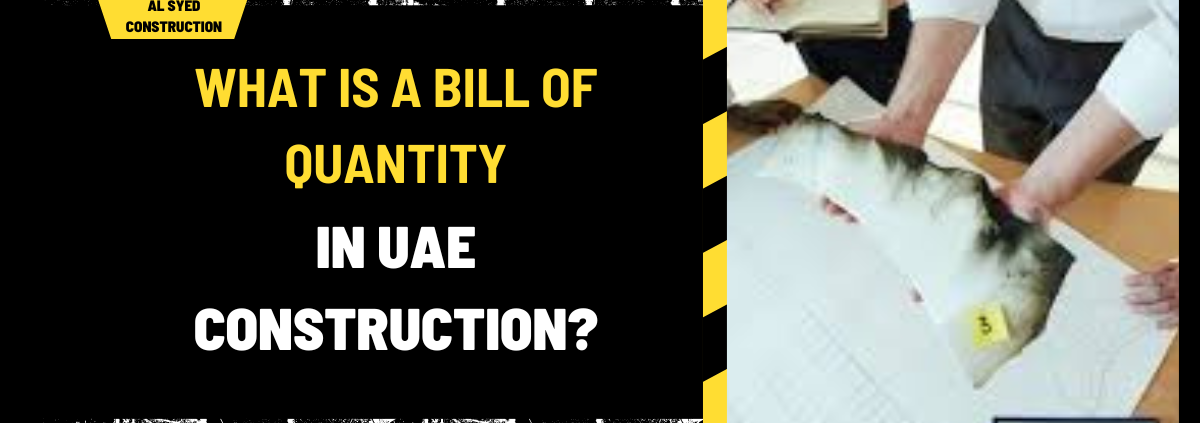What is a Bill of Quantity in UAE Construction? A Detailed Overview
In the construction industry, the Bill of Quantity (BOQ) is an indispensable document that ensures clarity and efficiency throughout the project lifecycle. This comprehensive guide delves into the essence of a BOQ, its importance, and its applications in the construction process. We will explore its components, benefits, and best practices to utilize it effectively.
Understanding the Bill of Quantity
The Bill of Quantity is a detailed document that itemizes all the materials, labor, and overhead costs associated with a construction project. It serves as a foundational tool for estimating, budgeting, and managing costs effectively. A well-prepared BOQ provides a clear and precise breakdown of project requirements, facilitating accurate bidding and contract management.
Components of a Bill of Quantity
A typical BOQ includes several key components:
1. Preliminaries
The preliminaries section outlines general conditions and requirements of the project. This includes site conditions, project constraints, and any specific requirements related to the execution of the project.
2. Description of Works
The description of works provides a detailed account of the construction activities and components involved. It includes a breakdown of various elements such as foundations, superstructures, and finishes, with precise quantities and specifications.
3. Quantities
The quantities section lists the amount of each material and work item required. This section provides detailed measurements and calculations, which are crucial for accurate cost estimation and procurement.
4. Rates and Costs
The rates and costs section assigns unit rates to each item listed in the BOQ. This includes the cost of materials, labor, and overheads. Accurate rate estimation is essential for developing a realistic budget and ensuring financial control.
5. Total Cost
The total cost section aggregates the individual costs to provide the overall project cost. This includes direct costs, indirect costs, and any contingencies. A precise total cost helps in securing funding and managing expenses throughout the project.
Importance of a Bill of Quantity
The BOQ plays a crucial role in various aspects of construction management:
1. Accurate Cost Estimation
A well-prepared BOQ enables precise cost estimation by providing a detailed breakdown of all project elements. This accuracy helps in avoiding budget overruns and ensuring financial viability.
2. Competitive Bidding
In competitive bidding scenarios, the BOQ provides a standardized basis for comparing bids. It ensures that all bidders are evaluating the same scope of work, leading to fair and transparent pricing.
3. Contract Administration
The BOQ serves as a reference document during contract administration. It helps in managing changes, verifying progress, and ensuring that work is completed as per the agreed specifications.
4. Resource Planning
By detailing the quantities and types of materials required, the BOQ aids in effective resource planning and procurement. This helps in minimizing delays and ensuring timely delivery of materials.
5. Project Monitoring
The BOQ facilitates project monitoring by providing a benchmark against which actual costs and progress can be measured. This helps in identifying deviations and implementing corrective actions promptly.
Creating an Effective Bill of Quantity
To ensure the BOQ is effective, adhere to the following best practices:
1. Detailed and Accurate Descriptions
Provide clear and detailed descriptions of all items and activities. This includes specifications, dimensions, and any relevant notes. Accuracy in descriptions helps in avoiding misunderstandings and discrepancies.
2. Consistent Measurement Units
Use consistent measurement units throughout the BOQ. This includes standard units for quantities such as square meters, cubic meters, and kilograms. Consistency ensures clarity and reduces errors in calculations.
3. Regular Updates
Update the BOQ regularly to reflect any changes in the project scope or requirements. This includes revisions due to design modifications, changes in material specifications, or alterations in construction methods.
4. Collaboration with Stakeholders
Collaborate with all relevant stakeholders, including architects, engineers, and contractors, during the preparation of the BOQ. Their input ensures that all aspects of the project are accurately represented and accounted for.
5. Compliance with Standards
Ensure that the BOQ complies with relevant industry standards and guidelines. This includes adherence to local building codes, construction regulations, and best practices in cost estimation.
Common Challenges and Solutions
1. Inaccurate Measurements
Inaccurate measurements can lead to significant discrepancies in the BOQ. To mitigate this, use precise measuring tools and verify measurements through multiple sources.
2. Scope Changes
Changes in project scope can impact the BOQ. Implement a robust change management process to address scope modifications and update the BOQ accordingly.
3. Cost Fluctuations
Fluctuations in material costs can affect the accuracy of the BOQ. Regularly review and adjust rates to reflect current market conditions.
4. Complexity of Projects
Complex projects may present challenges in preparing the BOQ. Break down complex elements into smaller, manageable components to ensure clarity and accuracy.
Conclusion
The Bill of Quantity is a vital document in construction that facilitates accurate cost estimation, competitive bidding, and effective project management. By understanding its components, importance, and best practices, construction professionals can leverage the BOQ to ensure successful project outcomes. Proper preparation and management of the BOQ contribute to financial control, resource planning, and overall project efficiency.




